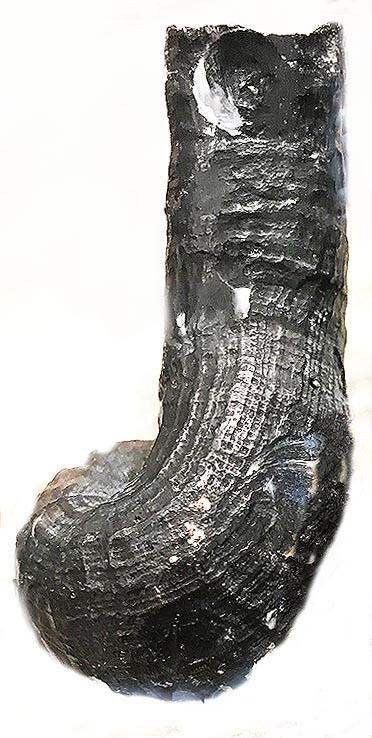This post concerns some marine gastropod (snail) shells that are irregularly coiled (twisted). In the 1950’s to 1960’s, workers assigned all irregularly coiled marine gastropods to family Vermetidae. Now, however, such snails are assigned to family Turritellidae, subfamily Vermiculariinae. These changes are examples showing that, these days, seashell classifications are “fluid” concepts and always subject to being revised.
Family Turritellidae, subfamily Vermiculariinae, Vermicularia knorri (Deshayes, 1843), 1.5 cm “width” of shell (from left to right of its mid-section, as viewed here). This species is common in the Gulf of
This gastropod shell (length 8 cm) is Tenagodus ponderosus (Mörch, 1861), an uncommon species that lives in shallow-marine depths in the waters off Queensland, Australia southwest Pacific. It is a prime example of twisted shells with a slit in their shells: thus belonging to family Siliquaridae.
For those that are interested, I wrote a paper (Squires, 1990) about my recognition of a new Paleocene species of genus Tenagodus based on my field work in southern California.
AN "END" NOTE
While examining my small collection of modern-day, irregularly coiled gastropod shells, I came across an unusual vermetid that I found many years ago as float on the beach at Coal Oil Point, Goleta,, Ventura County, southern California (illustrated below). It is noticeably different from other southern California vermetids by having a shell much larger in diameter and also much much darker in color.
Two views (side and top) of an unusual vermetid (9.5 cm length, 4.7 cm wide at its base, 2.2 cm diameter at its top) from Coal Oil Point, Goleta,Ventura County, southern California.
Identification of this unusual twisted gastropod proved to be problematic. Via the internet (Wikipedia and Invert-E-Base), I detected images of Thylacodes colubrinus, formerly known as Serpulorbis colubrinus. Thylacodes now belongs to family Vermetidae. Thylacodes colubrinus is known from China and the Philippines. Although somewhat blacker than the Goleta specimen, T. colubrinus is closer in morphology to it than any other vermetid I know about.
I contacted Lindsey Groves, Malacology Collection Manager at the Natural History Museum of Los Angeles County. He kindly provided me with photos (two included below) of the T. colubrinus from the Philippine Islands.
Thylacodes colubrinus from the Cebu Province, Philippine Island. Images of two specimens from the same cluster, courtesy of L. T. Groves. The straight-tube specimen is 2 cm long, and the other specimen is 3.5 cm long.
It is mystery how a vermetid that strongly resembles a species from the Philippines might occur in southern California. Its occurrence at Goleta is probably either accidental or on purpose. In situ collecting will be required to resolve whether or not this species positively occurs in California.
REFERENCES USED or CITED:
Invert-E-Base [via the WoRMS website]. 2024.
Squires, R.L. 1990. New Paleogene siliquariid and vermetid gastropods from the Pacific coast of southwestern North America. The Veliger 33(2):286–292, figs. 1-10. (pdf is free, via the website biodiversity library.
Wikipedia. 2024.
WoRMS, 2023: marinespecies.org







No comments:
Post a Comment